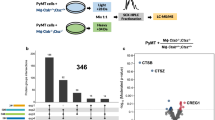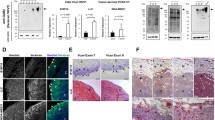Abstract
The matrix metalloprotease (MMP) family of enzymes and the urokinase plasminogen activator (uPA) pathway have both been implicated in tumor invasion and metastasis and in poor prognosis of cancer. We have previously shown that treatment with batimastat, a synthetic MMP inhibitor, leads to significant retardation but not regression of tumor growth in a human breast cancer xenograft model. In addition, batimastat treatment did not inhibit local tumor invasion, nor did it encourage stromal encapsulation of the tumor, suggesting the additional involvement of non-MMP proteolytic mechanisms. To investigate the presence of an alternative extracellular matrix protease whose activity is known to be important in breast cancer, but which is not inhibited by batimastat, expression of murine and human uPA were examined by in situ hybridization and ELISA. No differences were observed between untreated and batimastat-treated tumors regarding human uPA mRNA and protein. In contrast, murine uPA mRNA expression was increased at the tumor-stromal junction in batimastat-treated tumors in comparison with the control tumors. In agreement with these results, batimastat treatment was shown to significantly induce murine uPA protein content in the tumors. Inoculating MDA435/LCC-6 cells into immunodeficient, uPA-deficient mice resulted in tumor growth retardation as compared to tumor growth in littermate wild-type controls, while addition of batimastat treatment to uPA−/− mice did not result in further growth inhibition. The increased expression of stromal uPA may represent a cellular response to MMP inhibition and may demonstrate a new level of plasticity in the malignant progression of the disease. These results may have important implications for the clinical applications of MMP inhibitors, as well as for development of other anti-invasion drugs.
Similar content being viewed by others
References
Stetler-Stevenson WG, Hewitt R, Corcoran M: Matrix metalloproteinases and tumor invasion: from correlation and causality to the clinic. Semin Cancer Biol 7: 147-154, 1996
Brown PD, Giavazzi R: Matrix metalloproteinase inhibition-a review of anti-tumour activity. Ann Oncol 6: 967-974, 1995
Wang X, Fu X, Brown PD, Crimmin MJ, Hoffman RM: Matrix metalloproteinase inhibitor BB-94 (batimastat) inhibits human colon tumor growth and spread in a patient-like orthotopic model in nude mice. Cancer Res 54: 4726-4728, 1994
Watson SA, Morris TM, Robinson G, Crimmin MJ, Brown PD, Hardcastle JD: Inhibition of organ invasion by the matrix metalloproteinase inhibitor batimastat (BB-94) in two human colon carcinoma metastasis models. Cancer Res 55: 3629-3633, 1995
Sledge-GW J, Qulali M, Goulet R, Bone EA, Fife R: Effect of matrix metalloproteinase inhibitor batimastat on breast cancer regrowth and metastasis in athymic mice. J Natl Cancer Inst 87: 1546-1550, 1995
Taraboletti G, Garofalo A, Belotti D, Drudis T, Borsotti P, Scanziani E: Inhibition of angiogenesis and murine hemangioma growth by batimastat, a synthetic inhibitor of matrix metalloproteinases. J Natl Cancer Inst 87: 293-298, 1995
Low JA, Johnson MD, Bone EA, Dickson RB: The matrix metalloproteinase inhibitor batimastat (BB-94) retards human breast cancer solid tumor growth but not ascites formation in nude mice. Clin Can Res 2: 1207-1214, 1996
Stephens RW, Brünner N, Jänicke F, Schmitt M: The urokinase plasminogen activator system as a target for prognostic studies in breast cancer. Breast Cancer Res Treat 52: 99-111, 1998
Andreasen PA, Kjøller L, Christensen L, Duffy MJ: The urokinase-type plasminogen activator system in cancer metastasis-a review. Int J Cancer 72: 1-22, 1997
Nielsen BS, Sehested M, Timshel S, Pyke C, Danø K: Messenger RNA for urokinase plasminogen activator is expressed in myofibroblasts adjacent to cancer cells in human breast cancer. Lab Invest 74: 168-177, 1996
Grøndahl-Hansen J, Ralfkiaer E, Kirkeby LT, Kristensen P, Lund LR, Danø K: Localization of urokinase-type plasminogen activator in stromal cells in adenocarcinomas of the colon in humans. Am J Pathol 138: 111-117, 1991
Rømer J, Pyke C, Lund LR, Eriksen J, Kristensen P, Rønne E, Høyer-Hansen G, Danø K, Brünner N: Expression of uPA and its receptor by both neoplastic and stromal cells during xenograft invasion. Int J Cancer 57: 553-560, 1994
Werb Z, Mainardi CL, Vater CA, Harris ED, Jr: Endogenous activiation of latent collagenase by rheumatoid synovial cells. Evidence for a role of plasminogen activator. N Engl J Med 296: 1017-1023, 1977
Carmeliet P, Moons L, Lijnen R, Baes M, Lemaitre V, Tipping P, Drew A, Eeckhout Y, Shapiro S, Lupu F, Collen D: Urokinase-generated plasmin activates matrix metalloproteinases during aneurysm formation. Nat Genet 17: 439-444, 1997
Lyons RM, Gentry LE, Purchio AF, Moses HL: Mechanism of activation of latent recombinant transforming growth factor beta 1 by plasmin. J Cell Biol 110: 1361-1367, 1990
Saksela O, Rifkin DB: Release of basic fibroblast growth factor-heparan sulphate complexes from endothelial cells by plasminogen activator-mediated proteolytic activity. J Cell Biol 110: 767-775, 1990
Leonessa F, Green D, Licht T, Wright A, Wingate-Legette K, Lippman J, Gottesman MM, Clarke R: MDA435/LCC6 and MDA435/LCC6MDR1: ascites models of human breast cancer. Br J Cancer 73: 154-161, 1996
Carmeliet P, Schoonjans L, Kieckens L, Ream B, Degen J, Bronson R, De Vos R, van den Oord JJ, Collen D, Mulligan RC: Physiological consequences of loss of plasminogen activator gene function in mice. Nature 368: 419-424, 1994
Kristensen P, Eriksen J, Blasi F, Danø K: Two alternatively spliced mouse urokinase receptor mRNAs with different histological localization in the gastrointestinal tract. J Cell Biol 115: 1763-1771, 1991
Camiolo SM, Siuta MR, Madeja JM: Improved medium for extraction of plasminogen activator from tissue. Prep Biochem 12: 297-305, 1982
Declerck PJ, Verstreken M, Collen D: Immunoassay of murine t-PA, u-PA and PAI-1 using monoclonal antibodies raised in gene-inactivated mice. Thromb Haemost 74: 1305-1309, 1995
Solberg H, Rømer J, Brünner N, Holm A, Sidenius N, Danø K, Høyer-Hansen G: A cleaved form of the receptor for urokinase-type plasminogen activator in invasive transplanted human and murine tumors. Int J Cancer 58: 877-881, 1994
Benraad TJ, Geurts-Moespot J, Grøndahl-Hansen J, Schmitt M, Heuvel JJTM, de Witte JH, Foekens JA, Leake RE, Brünner N, Sweep CGJ: Immunoassays (ELISA) of urokinase-type plasminogen activator (uPA)-report of an EORTC/BIOMED-1 work-shop. Eur J Cancer 32A: 1371-1381, 1996
McCullagh P, Nelder JA: Generalized Linear Models. In: Chapman, Hall (eds), New York, 1989, pp 152-152
Diggle PJ, Liang K, Zeger SL: Analysis of Longitudinal Data. Clarendon Press, 1994, pp 201-202
Brown PD: Clinical studies with matrix metalloproteinase inhibitors. Acta Pathol Microbiol Scand A 107: 174-180, 1999
Davies B, Brown PD, East N, Crimmin MJ, Balkwill FR: A synthetic matrix metalloproteinase inhibitor decreases tumor burden and prolongs survival of mice bearing human ovarian carcinoma xenografts. Cancer Res 53: 2087-2091, 1993
Chirivi RG, Garofalo A, Crimmin MJ, Bawden LJ, Stoppacciaro A, Brown PD, Giavazzi R: Inhibition of the metastatic spread and growth of B16-BL6 murine melanoma by a synthetic matrix metalloproteinase inhibitor. Int J Cancer 58: 460-464, 1994
Grøndahl-Hansen J, Christensen IJ, Rosenquist C, Brünner N, Mouridsen HT, Danø K, Blichert-Toft M: High levels of urokinase-type plasminogen activator and its inhibitor PAI-1 in cytosolic extracts of breast carcinomas are associated with poor prognosis. Cancer Res 53: 2513-2521, 1993
Sappino AP, Busso N, Belin D, Vassalli JD: Increase of urokinase-type plasminogen activator gene expression in human lung and breast carcinomas. Cancer Res 47: 4043-4046, 1987
Danø K, Andreasen PA, Grøndahl-Hansen J, Kristensen P, Nielsen LS, Skriver L: Plasminogen activators, tissue degradation, and cancer. Adv Cancer Res 44: 139-266, 1985
Jankun J, Merrick HW, Goldblatt PJ: Expression and localization of elements of the plasminogen activation system in benign breast disease and breast cancers. J Cell Biochem 53: 135-144, 1993
Hildenbrand R, Dilger I, Horlin A, Stutte HJ: Urokinase and macrophages in tumour angiogenesis. Br J Cancer 72: 818-823, 1995
Montesano R, Pepper MS, Möhle-Steinle in U, Risau W, Wagner EF, Orci L: Increased proteolytic activity is responsible for the aberrant morphogenetic behavior of endothelial cells expressing the middle T oncogene. Cell 62: 435-445, 1990
Hulboy DL, Rudolph LA, Matrisian LM: Matrix metalloproteinases as mediators of reproductive function. Mol Hum Reprod 3: 27-45, 1997
Wojtowicz-Praga S., Low J, Marshall J, Ness E, Dickson R, Barter J, Sale M, McCann P, Moore J, Cole A, Hawkins MJ: Phase I trial of a novel matrix metalloproteinase inhibitor batimastat (BB-94) in patients with advanced cancer. Invest New Drugs 14: 193-202, 1996
Wojtowicz-Praga S, Torri J, Johnson M, Steen V, Marshall J, Ness E, Dickson R, Sale M, Rasmussen HS, Chiodo TA, Hawkins MJ: Phase I trial ofMarimastat, a novel matrix metalloproteinase inhibitor, administered orally to patients with advanced lung cancer. J Clin Oncol 16: 2150-2156, 1998
Benaud C, Dickson RB, Thompson EW: Roles of the matrix metalloproteinases in mammary gland development and cancer. Breast Cancer Res Treat 50: 97-116, 1998
Author information
Authors and Affiliations
Rights and permissions
About this article
Cite this article
Holst-Hansen, C., Low, J.A., Stephens, R.W. et al. Increased stromal expression of murine urokinase plasminogen activator in a human breast cancer xenograft model following treatment with the matrix metalloprotease inhibitor, batimastat. Breast Cancer Res Treat 68, 225–237 (2001). https://doi.org/10.1023/A:1012217820507
Issue Date:
DOI: https://doi.org/10.1023/A:1012217820507




